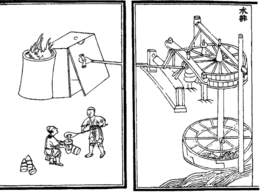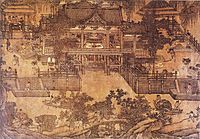Du Shi facts for kids
Du Shi (Chinese: 杜詩; pinyin: Dù Shī; Wade–Giles: Tu Shih, died 38 AD) was an important Chinese official and inventor. He lived during the Eastern Han Dynasty. Du Shi is famous for being the first person to use water power (from a waterwheel) to make bellows work. Bellows are devices that blow air. His invention helped to power blast furnaces and cupola furnaces, which were used to make cast iron. Cast iron had been known in China for a long time. Du Shi also worked as a government officer and manager in different places. He even led a small army to defeat bandits.
Contents
Life Story
Early Years
We don't know exactly when Du Shi was born. He grew up in Henei, which is in Henan province, China. He started his career as a local officer. In 23 AD, he became a government clerk. This was after a big revolt against the ruler Wang Mang. Soon after, Du Shi joined Emperor Guangwu of Han. Emperor Guangwu is known as the founder of the Eastern Han Dynasty.
Being a Censorate Officer
Under Emperor Guangwu, Du Shi became a Censorate officer. His job was to watch over things and make sure laws were followed in the capital city, Luoyang. One time, some soldiers were causing trouble and scaring people. Their leader, Xiao Guang, wasn't doing anything about it. Du Shi bravely arrested Xiao Guang. He even had Xiao Guang executed without waiting for the Emperor's direct permission. He sent a report to the Emperor only after it was done. Emperor Guangwu was not angry. Instead, he gave Du Shi a special sign that showed his actions were right.
After this, a bandit leader named Yang Yi was causing problems. Du Shi was sent to stop him. Yang Yi planned to run away across the Yellow River. But Du Shi was smart. He sent a group to burn the boats Yang Yi wanted to use. Then, Du Shi gathered local troops. He led a surprise attack with horse riders. They quickly defeated Yang Yi's bandits.
Working as an Administrator
For three years, Du Shi worked as a county leader in Henan province. People really liked how he managed things. Later, he became a manager in other areas like Pei and Runan. In 31 AD, he became the administrator of Nanyang.
While in Nanyang, Du Shi did many great things. He built many dykes and canals. These helped to reclaim land and grow more food for the local people. It was also here that he invented his famous water-powered machine. This machine used water to operate bellows for making cast iron. People said it saved a huge amount of hard work. The local people loved him so much that they called him "Mother Du." They even compared him to famous historical figures.
Du Shi was mostly a local leader. But he also gave advice to the Emperor's court. He suggested bringing back a system called "Tiger Tallies." This system helped the Emperor check if officials were honestly calling up troops for war. He also suggested other officials for important jobs in the capital.
His Final Years
In 38 AD, Du Shi became ill and passed away. Even though he had a long career as an official, he didn't have much money when he died. The Emperor heard about this. He ordered that Du Shi should have a proper funeral ceremony. He also sent silk to help pay for the costs.
The Water-Powered Blast Furnace
Du Shi's most famous invention was using water power for blast furnaces. These furnaces were used to melt and shape metal.
How it Worked
Du Shi used a waterwheel to power the bellows of a furnace. Bellows are like big pumps that blow air into the furnace. This makes the fire hotter and helps melt the metal. Before Du Shi, people had to use human or animal power to operate these bellows. His invention saved a lot of physical effort.
We don't have any of Du Shi's original bellows left today. So, experts are still not sure if they were made of leather or large wooden fans.
How the Idea Spread
Before Du Shi, old texts like the Sanguo Zhi (Records of the Three Kingdoms) show that people used human labor or horses to power furnace bellows. After Du Shi, other engineers also worked on similar ideas. For example, Han Ji (died 238 AD) reinvented a water-powered bellows. Later, Du Yu (222–285 AD) created another design.
In the 5th century, a text called Wu Chang Ji mentioned a special lake built just to power waterwheels for the iron industry. Other texts from the 5th and 9th centuries also talk about using river water to power waterwheels.
Even though Du Shi was the first to use water power for metal bellows, the oldest picture we have of such a device is from a book called Nong Shu. This book was printed in 1313 AD, during the Yuan Dynasty in China.
See also
- Antipater of Thessalonica
- List of Chinese people
- Trip hammer



